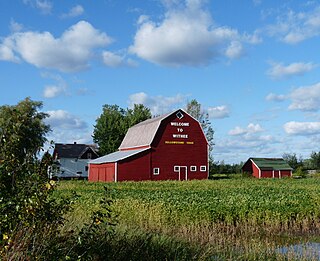Happy Valley is a census-designated place (CDP) in Kenai Peninsula Borough, Alaska, United States. At the 2010 census the population was 593, up from 489 in 2000.

Grayson is a census-designated place (CDP) in Stanislaus County, California, United States. The population was 952 at the 2010 census, down from 1,077 at the 2000 census. It is part of the Modesto Metropolitan Statistical Area.

Waimalu is a census-designated place (CDP) in Honolulu County, Hawaiʻi, United States. The population was 13,817 at the 2020 census.

Cissna Park is a village in Pigeon Grove Township, Iroquois County, Illinois, United States. The population was 846 at the 2010 census.

Maysville is a city in Scott County, Iowa, United States. The population was 156 at the time of the 2020 census.

Washington is a city in and the county seat of Washington County, Iowa, United States. It is part of the Iowa City, Iowa Metropolitan Statistical Area. The population was 7,352 at the time of the 2020 census.

Buffalo Center is a city in Winnebago County, Iowa, United States. The population was 857 at the time of the 2020 census. Its ZIP code is 50424.
Red Chute is a census-designated place (CDP) in Bossier Parish, Louisiana, United States. The population was 6,261 at the 2010 census. It is part of the Shreveport–Bossier City Metropolitan Statistical Area.

Lastrup is a city in Morrison County, Minnesota, United States. The population was 120 at the 2020 census.

Elko was a city in Scott County, Minnesota, United States. The population was 472 at the 2000 census. In January 2007, Elko merged with New Market to become Elko New Market.
Dickinson is a town in Franklin County, New York, United States. The population was 823 at the 2010 census. The town was named after Philemon Dickinson, a brigadier general of the New Jersey militia during the American Revolutionary War.
Constableville is a village in Lewis County, New York, United States. The population was 242 at the 2010 census. The village is named after William Constable, the son of an early landowner.

Burnham is a borough in Mifflin County, Pennsylvania, United States. The population was 2,054 at the 2010 census.
Midtown is a census-designated place (CDP) in Roane County, Tennessee, United States. Its population was 1,360 as of the 2010 census. Twice in the 1990s residents voted to incorporate as a town, and for a time the community maintained a municipal government, but the incorporation was challenged in court and eventually overturned after the state statute under which Midtown incorporated was ruled unconstitutional. It was a city at the time of the 2000 census, when the population was 1,306. It is included in the Knoxville Metropolitan Area.

Green Valley Farms is a census-designated place (CDP) in Cameron County, Texas, United States. The population was 1,272 at the 2010 census, up from 720 at the 2000 census. It is part of the Brownsville–Harlingen Metropolitan Statistical Area.

Laona is a town in Forest County, Wisconsin, United States. The population was 1,212 at the 2010 census. The census-designated place of Laona is located in the town. The unincorporated community of Blackwell Junction is also located partially in the town.

Cudahy is a city in Milwaukee County, Wisconsin, United States. The population was 18,267 at the 2010 census.

Thorp is a city in Clark County in the U.S. state of Wisconsin. The population was 1,621 at the 2010 census. The city is located partially within the Town of Thorp and partially within the Town of Withee.

Withee is a village in Clark County in the U.S. state of Wisconsin. The population was 487 at the 2010 census. The village is located mostly within the Town of Hixon, with a small portion extending south into the Town of Longwood.
Withee is a town in Clark County in the U.S. state of Wisconsin. The population was 885 at the 2000 census. The unincorporated community of Lombard is located in the town.

















